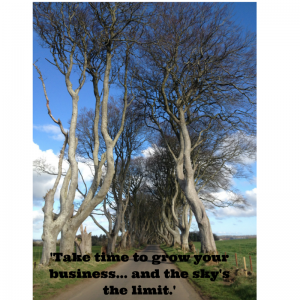Identifying tourist segments for marketing… it’s what I said I’d cover in this next blog and so I shall – with all details that follow sourced from those who know best – the tourism professionals. If you haven’t read my last blog, then that’s the people from Tourism NI and Tourism Ireland, along with Causeway Coast and Glens Borough Council (CCGBC), who held a conference entitled Partnership in Tourism Delivery at the Causeway Hotel the other week.
 So, do you know who you’re marketing your business and indeed, Northern Ireland, to when you’re online or compiling all that beautiful content? I’ve mentioned before how important it is to know your audience when it comes to marketing, so just who are the tourists you want to attract? Everyone? Well, yes – but let’s be more specific…
So, do you know who you’re marketing your business and indeed, Northern Ireland, to when you’re online or compiling all that beautiful content? I’ve mentioned before how important it is to know your audience when it comes to marketing, so just who are the tourists you want to attract? Everyone? Well, yes – but let’s be more specific…
Tourist segments include:
– Bikers: Motor-bikers to be exact. As Gareth Evans, head of rural development at DARD said, there’s a great potential for creating biker trails throughout Northern Ireland. Bikers love the place and we should tell them all about it.
“There’s the possibility of creating a trail from the Skerries (in the ROI), up to Northern Ireland, and building the infrastructure around these areas.”
– Culturally curious visitors: Peter Thompson, head of tourism and recreation at CCGBC, said businesses need to market to tourists in Great Britain who seek “good quality events and local experiences.”
– Great escapers: These are people who want an authentic experience from the place they visit. They seek excitement, so are you telling them everything they need to know about your region?
– Social energisers: This group is looking for entertainment, festivals, outdoor sporting activities and the like, so if you’re aware of anything like this near you, then make it known.
– Family fun: A tourism segment which prefers value for money experiences, lots of fun, safe activities and entertainment for the little ones.
– Mature cosmopolitans: Here, we have the older generation, who seek value for money, but also relaxation, fine food and drink – scenic drives and walks…. Have any ideas?
– Time together: This crowd is after high-quality food and drink; culture; the short break experience – and it’s gotta be good.
 Now, after identifying these target tourism segments, Mr Thompson went on to explain the council’s strategy for going after these potential visitors. This essentially involves all that you’d expect – attending tourism trade shows and events in the UK and Ireland, product development work, advertising campaigns and digital media campaigns. With posts still being finalised, the new council will have to wait until it’s clear who’s been allocated certain jobs – which was pointed out with regards to the digital marketing side of things – but hopefully social media will be harnessed fully when it comes to marketing the province.
Now, after identifying these target tourism segments, Mr Thompson went on to explain the council’s strategy for going after these potential visitors. This essentially involves all that you’d expect – attending tourism trade shows and events in the UK and Ireland, product development work, advertising campaigns and digital media campaigns. With posts still being finalised, the new council will have to wait until it’s clear who’s been allocated certain jobs – which was pointed out with regards to the digital marketing side of things – but hopefully social media will be harnessed fully when it comes to marketing the province.
As a former newspaper journalist, I know the value of print advertising, but we all know that a re-tweet on Twitter can get you thousands of views in an instant and that viral online posts give great global awareness. While the tourism segments identified at the conference were mostly discussed in terms of UK and Irish visitors, we’d already heard how an abundance of German and other European visitors are flooding into the ROI but failing to continue the journey up north. The reason? Because they don’t realise there’s so much to do here. That, for me, is where online marketing comes in.
 If every business began blogging, tweeting and posting regular useful and informative content online – using business Twitter hours, tagging tourism companies etc. – we could really shout about Northern Ireland and get the word out a lot faster. The tourism chiefs are doing a great job already, but as they all admitted at the conference – it’s about businesses working cohesively to champion our island. Hence the name of the event – Partnership in Tourism Delivery. They need us on the ground as well.
If every business began blogging, tweeting and posting regular useful and informative content online – using business Twitter hours, tagging tourism companies etc. – we could really shout about Northern Ireland and get the word out a lot faster. The tourism chiefs are doing a great job already, but as they all admitted at the conference – it’s about businesses working cohesively to champion our island. Hence the name of the event – Partnership in Tourism Delivery. They need us on the ground as well.
Mary O’Driscoll from the Rathlin Island Ferry Company was the final speaker of the day, and her work to date demonstrates perfectly how communities working together can have multiple benefits for all. She also mentioned another recent initiative, the popular Ballycastle Market, saying that “partnership is their strength.” 
As she pointed out, competitors and businesses need not necessarily like each other, but if they can all get along and work together to attract the tourists, then everyone will benefit.
She added: “We have to get this right, and get it right together, before we can go to the next stage.”